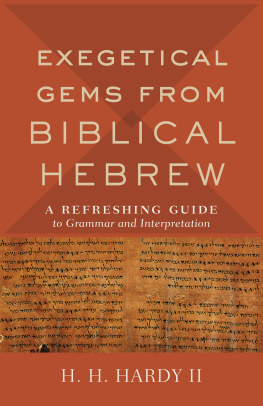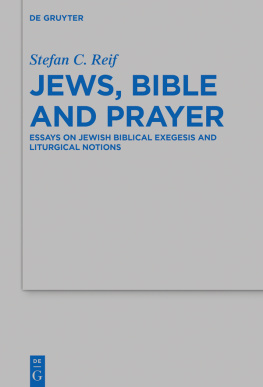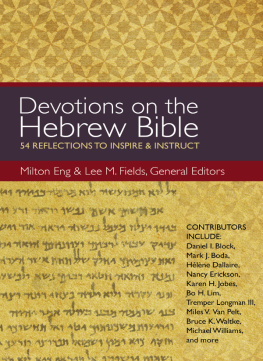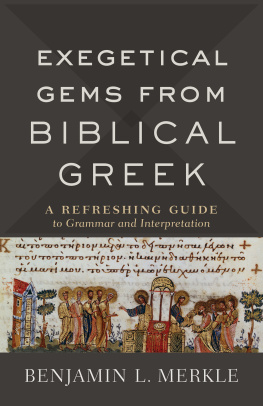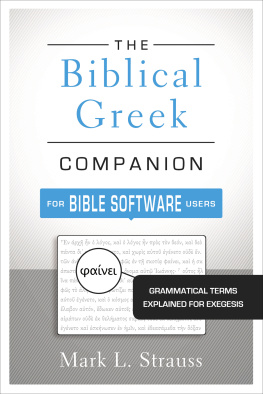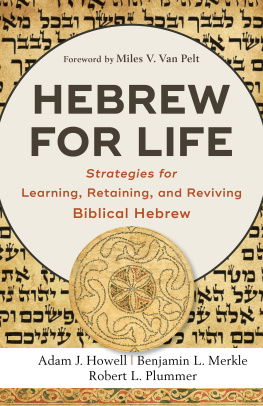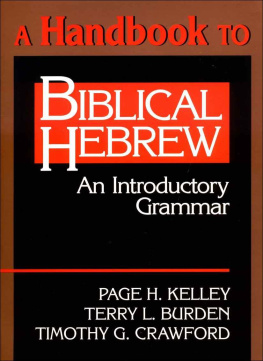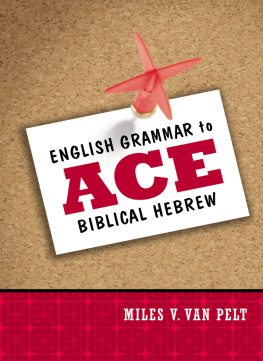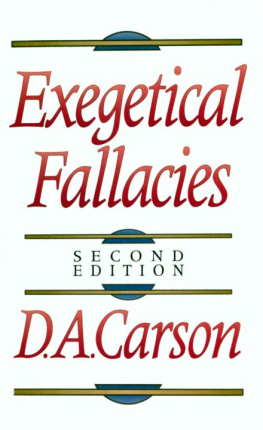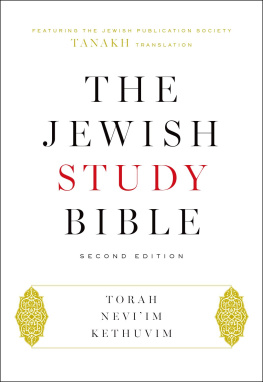Endorsements
This handy volume polishes and exposes the brilliance of the nuggets to be mined in the soil of Biblical Hebrew morphology and grammar. With thirty selected topics and carefully chosen examples, Hardy demonstrates the value of paying close attention to the details of language to discover the precious truths of Scripture. The collection itself is a major gemstone. I regret that I did not possess this treasure five decades ago, when I was learning Hebrew, and that it was not previously available to all my Hebrew students.
Daniel I. Block , Wheaton College
Many theological students spend hours laboring to learn the grammar of Biblical Hebrew. Although many excellent grammars are available, few works help students take the next step and see the exegetical payoff from studying the Old Testament in Hebrew. Hardys helpful resource now addresses this problem. With well-chosen examples from the biblical text, the author leads students through key areas of grammar, lexica, and syntax. This book provides an important bridge to help students move from a knowledge of grammar to informed exegesis of the Hebrew text.
David Firth , Trinity College, Bristol
Truly a refreshing guide to Hebrew grammar and Old Testament interpretation! Hardys mastery of the biblical languages is matched with clear explanations and great exegetical examples. He writes with the skill of a scholar, the seasoning of a teacher, and the heart of a shepherd who cares deeply about biblical faithfulness. This book will motivate students to persevere in Hebrew study, and it will show them how to apply the concepts they are learning. I am delighted to have such a volume to use in the classroom.
Jason S. DeRouchie , Bethlehem College and Seminary
Hardy leverages his considerable knowledge of Biblical Hebrew to demonstrate the exegetical payoff from learning the language. Each chapter concisely introduces a key topic related to Biblical Hebrew and then illustrates how that topic relates to the interpretation of a particular passage. This is an ideal resource for newer students and for those who want to dust off their Hebrew skills through practical application.
Nicholas J. Reid , Reformed Theological Seminary, Orlando
Eves temptation, Abrahams ram, Leahs eyes, Aarons goats, Davids heart, the Shunammite womans son, Zedekiahs danger Exegetical Gems from Biblical Hebrew zeros in on exegetical questions arising from specific biblical verses. Hardy draws on his expertise in ancient Near Eastern languages and cultures, skillfully walking us through grammatical topics, strengthening our grasp of Hebrew, and proposing helpful solutions to interpretive dilemmas. This book will be valuable to students, lecturers, and anyone wishing to revive their Hebrew. I look forward to using this material with my students.
Jill Firth , Ridley College, Melbourne
Title Page
Copyright Page
2019 by H. H. Hardy II
Published by Baker Academic
a division of Baker Publishing Group
PO Box 6287, Grand Rapids, MI 49516-6287
www.bakeracademic.com
Ebook edition created 2019
All rights reserved. No part of this publication may be reproduced, stored in a retrieval system, or transmitted in any form or by any meansfor example, electronic, photocopy, recordingwithout the prior written permission of the publisher. The only exception is brief quotations in printed reviews.
Library of Congress Cataloging-in-Publication Data is on file at the Library of Congress, Washington, DC.
ISBN 978-1-4934-1804-6
Unless otherwise indicated, all Scripture quotations are the authors translation. All rights reserved.
Dedication
To Peter J. Gentry and Daniel I. Block
Contents
Cover
Endorsements
Title Page
Copyright Page
Dedication
Introduction
Abbreviations
1. Hebrew Language and Literature
Ezekiel 9:4
2. Textual Criticism
Genesis 22:13
3. Word Studies
Genesis 29:17a
4. Construct Phrases
Genesis 29:17b
5. Definiteness
Proverbs 31:1
6. Adjectives
Haggai 1:4
7. Pronouns 1
2 Kings 8:1b
8. Pronouns 2
2 Kings 8:1a
9. Verb Conjugations 1: qatal = wayyiqtol
Exodus 16:3435
10. Verb Conjugations 2: w qatal = yiqtol
Leviticus 16:19
11. Verb Conjugations 3: Jussives
Ruth 1:8b
Leviticus 16:2
13. Verb Conjugations 5: Cohortatives
2 Samuel 24:14
14. Verb Conjugations 6: Active and Passive Participles
Jeremiah 20:9
15. Verb Conjugations 7: Infinitives Construct
Jeremiah 27:10
16. Verb Conjugations 8: Infinitives Absolute
Jeremiah 7:910
17. Stative and Fientive Verbs
Psalm 93:1
18. Indefinite Subjects and Impersonal Verbs
1 Kings 1:1
19. Verb Stems 1: Voice and Valency
Genesis 12:13
20. Verb Stems 2: Semantics
2 Samuel 7:1
21. Negations
Genesis 3:4; 2:17
22. Prepositions 1: - i
1 Samuel 13:14
23. Prepositions 2: i
Genesis 2:17
24. Directive Heh
Exodus 13:21
25. Verbless Clauses
Deuteronomy 6:4
26. Interrogatives
Joshua 5:13b
27. Particles: i
Deuteronomy 14:24
Ruth 1:1
29. Relative Clauses
Psalm 119:85
30. Pragmatics: i
Genesis 1:31
Scripture Index
Back Cover
Introduction
This book is dedicated to my earliest teachers of Hebrew, one of whom is known to quip spiritedly, One cannot have good theology without good morphology!
While this aphorism may offer little comfort to a first-year Hebrew student languishing under the heavy weight of weak-verb paradigms, vocabulary cards, and never-ending derived stems, the sentiment is exactly right. Christian theology requires understanding Hebrew (and Greek).
Yahweh uses language to create the world. His words produce reality, and reading the Scriptures forms our understanding of him. No proper knowledge of God can be constructed apart from careful attention to his words. Whats more, God uses the standards of human language (i.e., grammar) to communicate his message. Grammar is our interface to engage the Bible and ultimately God. It is the hilt of the double-edged sword of Gods Spirit (Heb. 4:12). Without such a handle, the blade cannot be wielded. It returns void.
Believers throughout time witness this truth. Our Lord (himself a dutiful student, see Luke 2:46!) urges his disciples to discern carefully the Scriptures that were written about him (Luke 24:2527, 4445). His is a story that does not begin in a Bethlehem crib but at the birth of creation (Gen. 1:1; John 1:1). From beginning to end, his admonition is to inspect studiously the authoritative Word of God to confirm him (John 5:39). Understanding his mission and message as (according to the Scriptures) is a constant refrain throughout the Gospels and the NT (Acts 18:28). Even his death and resurrection, we are told, fulfill the longings of the Expounding the images and likenesses evidenced in the Law and the Prophets, Ephrem brings together the revelation of the mysteries of the Messiah as human and divine.
The teachers were ashamed that they grieved the Son,
For, truly the Law carries all likenesses [] of Him,
And likewise, the Prophets, as servants, carry
the images [] of the Messiah who rules everything.
Nature and the Scripture together carry
the mysteries [] of his humanity and of his deity.
Ephrem claims that these mysterious truths are manifest through careful attention to the Scriptures.
To this end, Martin Luther admonishes his pupils to engage the languages. Young divines ought to study Hebrew ( Tabletalk 425). Hebrew is, according to Luther, the originating spring from which all theology flows, and no one can really understand the Scriptures without it.

